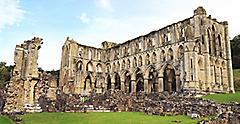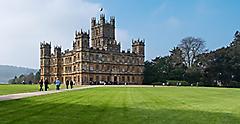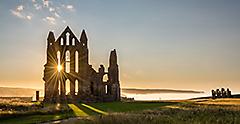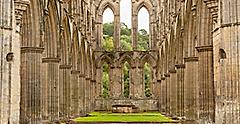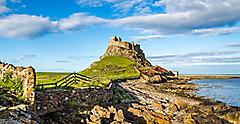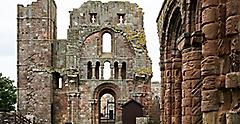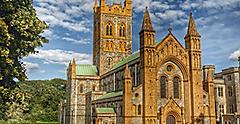By Melissa Alvarado Sierra | Published on November 29, 2023
When I decided to cruise to England, I knew I wanted to dive into the country's history by way of its ancient architecture, and exploring the abbeys in England was one of the best ways to achieve just that. Locals shared that anyone traveling to the British Isles must visit the majestic historic homes in England, both the ones in ruins and the ones still operating. I had heard about abbeys before, but I wasn't sure what they were. During a tour, the guide went through a lengthy list of abbeys in England, and I learned that an abbey is a set of buildings with a convent or monastery. The buildings also included a church or cathedral, and were headed by an abbot or abbess and served as the homes to monks and nuns of different communities or orders, such as Benedictine, Carthusian, Cistercian and Cluniac.
England is famous for abbeys that date back to medieval times, many of which were reclaimed by King Henry VIII when he separated from the Catholic Church in the 1530s — an event known as the Dissolution of the Monasteries. After the dissolution, most of the abbeys only retained the abbey church, which many just call an abbey. After learning what an abbey was, I wondered — why are English estates called abbeys? The answer is that many of these repossessed abbeys were gifted to the English nobility, and the families built mansions on those grounds, usually incorporating the ancient structures into their home design. These old homes in England were later known as estates, but their owners kept the original names that included the word "abbey."
Celebrated Abbeys In England
Everyone on my vacation tour was asking about one of the most famous historic homes in England, and one of the most famous "abbeys." Maybe you've heard of it? Downton Abbey. But where is Downton Abbey located in England? While the abbey itself is fictional, the filming site of the popular television show is in Newbury at Highclere Castle, which was once the official residence of the Bishops of Winchester. Another famous abbey to visit on a vacation to London is Westminster Abbey, found west of the Palace of Westminster. It is known as a royal abbey church because this is where British monarchs are coronated and where 16 royal weddings have taken place.
Next on my list of abbeys to visit was Rievaulx Abbey, located in Yorkshire. I found this abbey to be very tranquil and photogenic, with impressive ruins set in the North York Moors National Park — a peaceful and secluded valley. The atmospheric abbey and setting brought to life scenes from books like Wuthering Heights, one of my favorite novels. To further immerse myself in this magnificent place, I joined an audio tour.
Rievaulx Abbey was one of the first Cistercian abbeys in England, founded in 1131 by Walter Espec. It was originally made out of timber as a temporary building until the stone structures were erected in 1132. Close to a thousand years of history are reflected in the architecture, which holds spiritual and commercial meaning. After the dissolution, the abbey forge initially became a site for ironwork but later turned into a symbol of the Romantic period, with poets, scholars and artists documenting its beauty and history. I took some time to enjoy the ruins and sat by one of the massive pillars. There was a carpet of grass filling the inside floor of the abbey. I could not believe that so much beauty could be found in such a desolate place. To wrap up my visit to Rievaulx Abbey, I stopped by the museum, where I found recently discovered artifacts from the abbey, including chess pieces and coins — items signaling the amazing trajectory of the Cistercian site.
Crossing Times
My next abbey was more remote than I originally anticipated. Lindisfarne Priory, on the isolated and mysterious Holy Island, is found off the Northumberland coast, just a few miles from the Scottish border. Its location makes for a great day trip on your England vacation. While I was excited to travel to this destination, there was one little detail I needed to figure out: tides. Twice daily, the island becomes inaccessible once high tide washes over the raised causeway that leads to the island. So, I needed to check the safe crossing times. Once I found a safe time, I was delighted by a drive that included incredible views of the sea. Then, I was welcomed to the island by charming cafés, the jaw-dropping Lindisfarne Castle and, of course, the ancient Lindisfarne Priory.
I followed in the footsteps of ancient monks and discovered their mesmerizing stories. They lived on Holy Island and were the victims of Viking invasions, which forced them to flee the priory, eventually settling in Durham. But not all was tragic in the abbey. The monks were also able to create the exquisite and celebrated Lindisfarne Gospels, a group of illuminated texts that are now in the British Library. The Lindisfarne Priory was one of the most important centers of early Christianity in England — a site that still attracts pilgrims from far and wide.
A Battle, A Stone And A Gate
Get Royal Deals, Sign Up Today

Getting There
Explore Our Most Affordable Itineraries
Sail to the mystical British Isles and discover its ancient beauty via impressive monastic abbeys.
Related Articles

The Best Time to Visit Bermuda | Royal Caribbean Cruises
READ MORE

Girls and guys weekend trip ideas: How to plan a cruise getaway | Royal Caribbean Cruises
READ MORE

Best Long Weekend Getaways to the Bahamas on Utopia of the Seas | Royal Caribbean Cruises
READ MORE

Can You Take Days Off Without PTO? Here's What You Need to Know | Royal Caribbean Cruises
READ MORE

